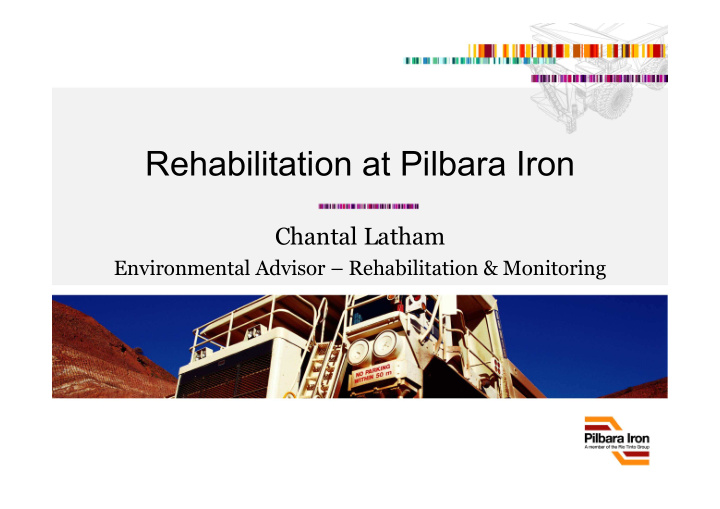



Rehabilitation at Pilbara Iron Chantal Latham Environmental Advisor – Rehabilitation & Monitoring
Location of Rio Tinto Businesses
Pilbara Iron • Pilbara Iron (PI) was established in 2004 and manages, operates and maintains facilities on behalf of asset owners, Hamersley Iron and Robe River Iron Associates • Network of 10 mines, three ports, and the largest privately owned heavy haul railway in the world • Iron ore exports in 2006 totalled 150 million tonnes • PI employs over 4,000 people
Pilbara Iron Operations
Rehabilitation Process Flow 1. Pre-Disturbance 7. Closure Criteria and Assessments Relinquishment 2. Mine and 6. Monitoring Closure Plans 5. Implementation 3. Research and Trials 4. Seed Management
1. Pre-Disturbance Assessments • Information collected from biological surveys feed into rehabilitation: – Species list – Introduced species list – Description of DRF, Priority and significant flora and fauna – Description of vegetation communities – A map of vegetation units and their condition rating – Photographs of vegetation to be cleared – Classification and description of soil types – Coordinates for sample locations for rehabilitation criteria establishment or comparison
2. Mine and Closure Plans • Closure plans (Rio Tinto Closure Standard) • Life of mine plan (Rio Tinto Mineral Waste Standard) • 5 year mine plan * • 2 year mine plan (updated quarterly) • 3 month operational plan eg. Scheduled topsoil movements at Tom Price 2007 2008 2009 2010 Quantity to haul kt 50 300 300 181 Storage volume m 3 required 27,778 166,667 166,667 100,556
2. Mine and Closure Plans • Standard berm and bench waste dump designs • Topsoil scheduling and stockpile locations • Scheduling of potentially acid forming waste rock • Rehabilitation schedule to be developed
3. Research and Trials • Concave slope trials • Rainfall simulation and soil characterisation • Store and Release Covers • Trials of fertiliser, seeding rates and topsoil depths • Research partner in Telfer’s ‘Ecohydrological feedbacks between vegetation and soil in natural and engineered landforms in arid Australia’ project Rainfall Simulation at Nammuldi Cover Trial at Tom Price
Nammuldi Lens C Waste Dump Concave Slope Trial. Completed March 2007.
4. Seed Management • Provenance seed collection • Priority flora seed collection • Seed storage • Seed mixes • Seed application - Hand Vs Machine • Seed viability testing • Seed treatment trials to break dormancy • Increased involvement of traditional owners • Looking at a Millennium Seed Bank Partnership
5. Implementation - Landform • Landform earthworks – In-pit disposal preferred, but often not achievable – Water harvesting of incident rainfall – Direct water away from dump edges – Reduced slope angles for highly erodable materials – Berms (or Terraces) 10m wide, back sloping, 1 m deep, cross bunds every 100m – 2m abandonment bund at dump crest and toe A rehabilitation berm at Marandoo
5. Implementation - Erodibility High Moderate Low
5. Implementation - Topsoil • Recover 300mm of topsoil and 500 mm of subsoil • Direct return whenever possible • Unique stockpile design • Return topsoil at 200 mm Topsoil/subsoil stockpile design and recovery Topsoil is paddock dumped on top (max 3m) Topsoil and subsoil is Subsoil is mixed as it is leveled to a recovered max. height using a of 5m loader
5. Implementation - Topsoil Topsoil and seeded No Topsoil. Only seeded NEBC - Tom Price Rehab (1999)
5. Implementation (Cont.) • Ripping along the contour • Triple tyne • Continual Improvement: – Rock Armouring – Vegetation Mulch – Appointment of Environmental Advisor - Rehabilitation and Monitoring in 2006.
6. Monitoring • A large scale review and assessment of vegetation monitoring is underway: – Toolbox = Desktop reviews, Ecosystem Function Analysis, botanical surveys, remote sensing, photographic monitoring. • Key question to be addressed: – Is intervention required? Landscape Function Analysis assessment on Mesa N at Pannawonica December 2006
7. Closure Criteria and Relinquishment eg. Tom Price Mine Use components of the mine as a tourist attraction, for recreation facilities or the development of other viable Future Land Use Option economic activities and restore the remainder of the lease to native vegetation. Rehabilitation Objectives & Targets Positive net Sustainable Post-mining Safe, stable and impact on endemic landforms that uncontaminated. biodiversity. vegetation minimise water Aesthetically communities. ponding and are compatible. non-polluting.
In Conclusion • Ongoing Issues: - Full integration of rehabilitation into the mine plan - Appropriate and efficient monitoring - Development of closure criteria • We are always looking for improvement ideas and therefore techniques are continually evolving What more could Pilbara Iron be doing? Waste dump rehabilitation at Marandoo
Recommend
More recommend